
The Keeper of Izmir
After 40 years in Israel, Nesim Bencoya returned to his once-cosmopolitan hometown in Turkey to save its hidden synagogues.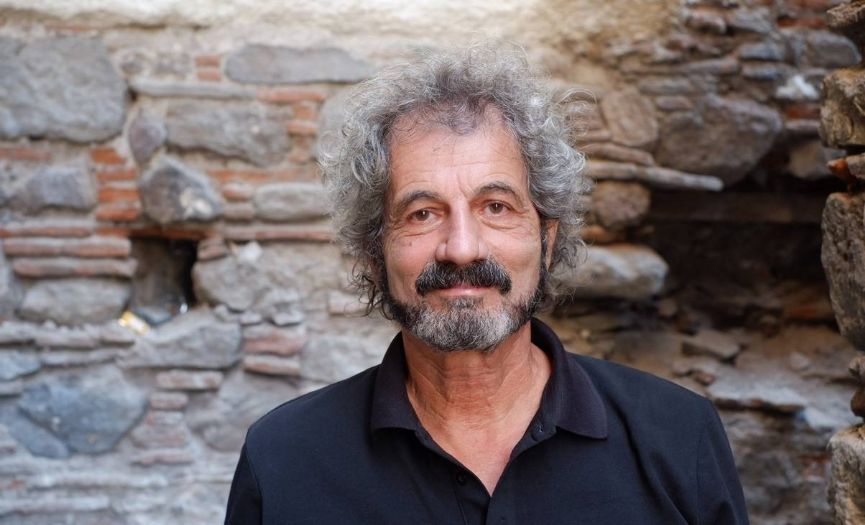
By Paul Benjamin Osterlund, January 4, 2022, Tablet Magazine
From the expansive rooftop of a grubby, eight-floor parking garage in the center of Izmir, one is greeted with a spectacular panoramic view of Turkey’s third-largest city. To the north and west is the downtown area, and just beyond is the curving coastline of the Gulf of İzmir, tucked into a pocket of the Aegean Sea. Right across the street stands the heart of the city’s old Jewish quarter, concentrated around Havra Sokak (Synagogue Street).
Synagogue Street is a busy, dense, and cacophonous outer section of Izmir’s Kemeralti Bazaar, a massive open-air market with centuries of history that still functions as an important space of commerce. The street is lined with vendors gutting, cleaning, and selling fresh fish, and butchers hawking various types of organ meats, racks of lamb, and whole chickens. The stench is pungent to say the least, and packs of stray dogs and cats are on the prowl after fallen morsels. Kemeralti is bustling by day but mostly dark and eerily silent at night, though bars and restaurants have recently opened in certain parts of the market, providing light and energy to its maze of empty streets and shuttered shops.
I’m standing atop the roof on a sunny October day with 66-year-old Nesim Bencoya, a native of Izmir and a member of the city’s dwindling Sephardic Jewish community, which numbers about 900 to 1,000 today. From above, Bencoya points out the nine synagogues—some in good condition, others in advanced stages of decay—located in very close proximity to one another on both sides of Synagogue Street. In the foreground is an empty lot and a crumbling building that housed Politi Şaraphanesi, a kosher winery that closed in the 1940s.
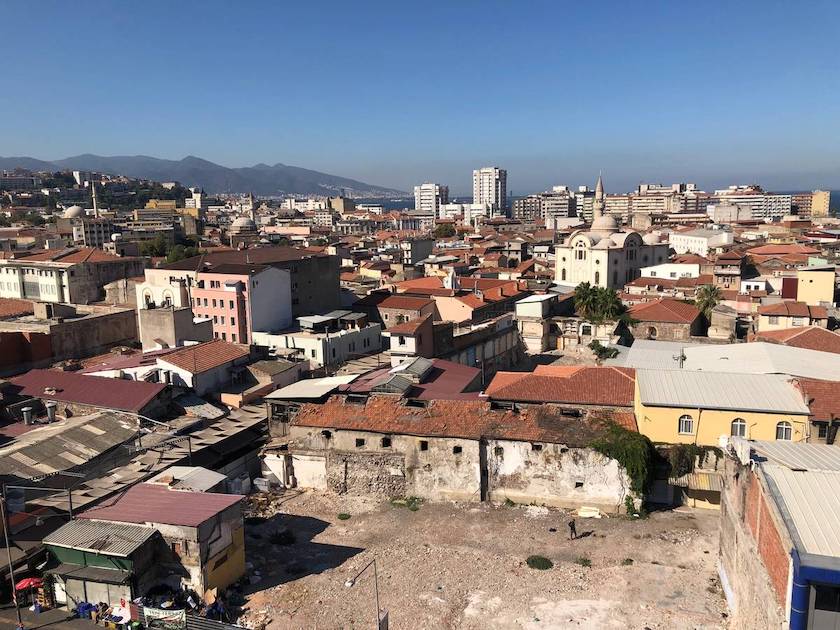
Synagogue Street with the crumbling wine house in the foreground (Courtesy the author)
“Imagine a roof,” Bencoya says, waving his arm around the compact quarter that encompasses the synagogues. He doesn’t mean a literal roof enclosing the area, much of which is in disarray, but envisions a restored, integrated heritage center linking the synagogues and adjacent backstreets. As general coordinator of Izmir’s Jewish Heritage Project, Bencoya is the primary force behind this expansive project, which brought him back to his hometown in 2010 after nearly 40 years in Israel, having moved to Haifa for college and worked as the director of the city’s Cinémathèque for 15 years.
Around that time, the chairwoman of Israel’s Kiriaty Foundation, who owned a business in Izmir, came across the sad state of the Kemeralti synagogue and launched the project, tapping Bencoya to helm it. It was in the planning stages for more than a decade, and restoration on two of the synagogues began earlier this year within the scope of the project. Funding has come from a number of sources, including a six-figure grant from the European Union delegation to Turkey.
Bencoya is slender and energetic, dressed casually in trousers, sneakers and a polo shirt with a mop of curly gray hair, a thick black mustache, and a salt-and-pepper beard. He looks younger than 66 and speaks with enthusiasm and conviction. He fields numerous phone calls as he sips coffee during our chat, mostly to do with the restoration project.
“I didn’t grow up in a religious family. Until I was 15 years old I would go with my father on High Holidays to the synagogues, and I don’t even remember which one we went to,” Bencoya says. Though he has since immersed himself in the history of the synagogues, he didn’t know much about them until returning from Israel in 2010. It wasn’t just the project that brought Bencoya back to his hometown after so many years abroad: Coupled with feelings of nostalgia, he’d also started to receive offers to direct some of Turkey’s most prestigious film festivals, and had fallen in love with a film professor based in the city.
“Being very active and committed to promote Jewish cultural heritage in the city, I feel that I am offering some pride to a people who for a long time has preferred to live unnoticed. To my satisfaction I see that Jewish people embrace that,” Bencoya says. “Five out of the nine synagogues we have here were in a very bad state. Three of them you couldn’t really enter because of the rubble, the roofs collapsed. Over time, it became a forest actually, from the Hevra and Forasteros [synagogues] we uprooted 20 trees from each one. We’re going to have access to all nine places, which makes a beautiful tour.”
But for Bencoya, the project goes far beyond restoration, and he has two distinct personal reasons for being involved in this demanding, grandiose project.
“I didn’t know it at the beginning but now I know better. I see this project not as an architectural project within the framework of rebuilding or preserving the old, collapsed buildings. First, I want to tell a story that I find very interesting which is linked to the story of İzmir and of Turkey, and of the Ottoman Empire. So it’s a universal thing and it excites me,” he says.
“The second thing, which is also very important for me, I have been a Jew who has lived in a community of Jewish people who hid their identity. They went to pray in the synagogues, they knew they are Jews, they kept traditions but they changed names, for example,” Bencoya goes on, mentioning that instead of Nesim, people would call him Nedim, a Turkish name.
“According to surveys, Turkey is very antisemitic in terms of people’s attitudes, and those people usually did not meet any Jewish person in their lives. I think and I believe that this project is the biggest fight against antisemitism. If I don’t expose myself as I am, there is nothing that I can make advocacy for, and then I get erased and then I die. OK, there are buildings and very nice architecture, but what is in it, what is its meaning?”
For centuries after their expulsion from Spain, the Sephardic Jews of Turkey spoke their mother tongue of Ladino, or Judeo-Spanish, throughout the parts of the Ottoman Empire in which they settled. But though Bencoya and other younger generations of Turkish Jews can speak and understand Ladino, it fell out of favor throughout the 20th century due to the demands of the new republic’s nationalism.
“We didn’t speak Ladino. My generation didn’t speak Ladino because we didn’t want to feel different. There was pressure on Jews and other minorities to be Turkish, to behave Turkish, to speak Turkish,” Bencoya says. Izmir’s Jewish population peaked at around 40,000 in the 19th century and was an important fixture of the city’s commercial and cultural life. The city also had significant populations of Greeks and Armenians, which are nonexistent today.
As in Istanbul, which was also a more cosmopolitan city before the establishment of the Turkish republic, minorities in Izmir left or were forced out due to a series of ethno-nationalist policies, like the "Citizen, speak Turkish!" initiative, which scapegoated Jews in particular as many chose to speak Ladino and French in public. In addition to economic reasons, this eventually left only a small remaining Jewish population in Turkey, between 15,000 and 20,000 today, most of whom live in Istanbul. (One reputable source estimates a peak Jewish population of 300,000 during the late Ottoman period.) Persistent antisemitism has resulted in many young people leaving for Israel, and in recent years, Islamist groups have protested outside of Istanbul synagogues, holding the Turkish Jewish community responsible for episodes of escalating violence between Israelis and Palestinians. According to Bencoya, many of the country’s Jews simply left for a better economic future, adding that the wealthiest members of the community have stayed.
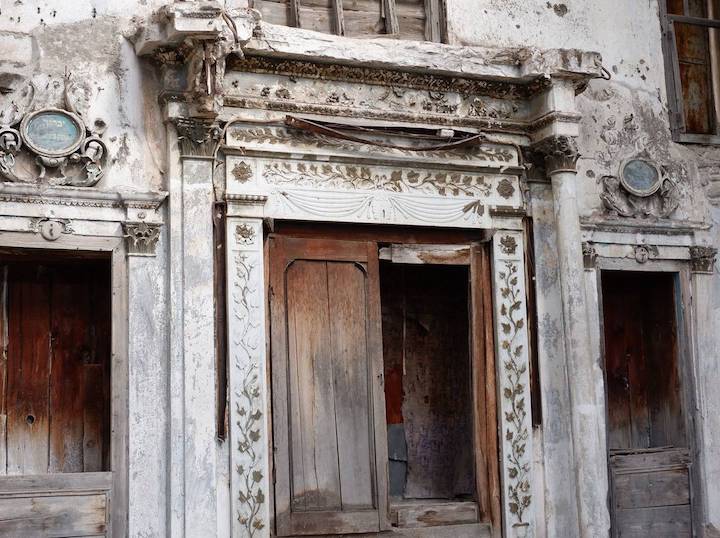
Hevra Synagogue (Courtesy the author)
Despite numbering no more than 1,000, Izmir’s Jewish community is Turkey’s second largest, a result of its historical role as a pivotal port city and trade center. Nevertheless, congregations are still active at three of the intact synagogues in Kemeralti: Signora Geveret, Algazi, and Shalom, in addition to the Bet Israel Synagogue in the neighborhood of Karataş.
Sephardic Jewish culture and cuisine have left their mark on the city, and Izmir’s signature snack is boyoz (etymologically linked to the bollos of Latin America) a flaky, savory, fist-size pastry served in carts all over the city that goes well alongside slices of boiled egg doused in black pepper. The late singer Dario Moreno, who was born in a neighboring province and grew up in Izmir as an orphan, remains among the city’s most iconic artists.
The Portekiz Synagogue, built by Sephardic Jews from Portugal in the early 17th century, today functions as a museum. It has been fully restored, though the structure was almost entirely destroyed by a fire in 1976. Just across the main avenue lies the ancient Agora of Smyrna, built in the Roman period in the fourth century BCE and excavated in 1933 just 10 years after the establishment of the Turkish republic.
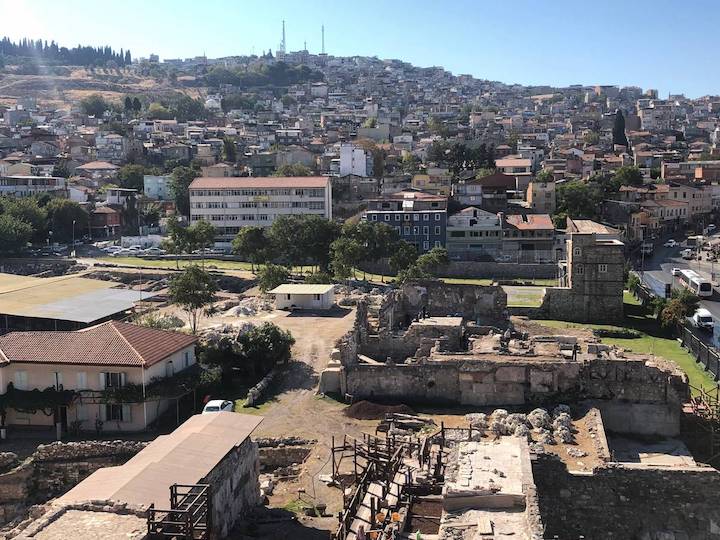
Izmir Agora with Zevi’s house in the corner (Courtesy the author)
In the corner of the agora stands the restored home of the infamous Sabbatai Zevi, a rabbi who claimed to be the messiah and attracted the ire of both Jews and Ottoman Muslims alike. He nevertheless assembled a serious following, the center of which became the Portugal Synagogue. Associated with Jewish converts to Islam who historically maintained their faith in secret, the term “Sabbatai” is still found in the rhetoric of Islamist pundits in Turkey who employ it as an antisemitic trope when attacking their opponents.
The Forasteros Synagogue is one of those that has been newly emptied of tons of rubble due to roof collapse. I find a tiny scrap of paper printed in Ladino tucked in a divot of one of the old walls, which are designed intricately with mid-Ottoman era brick and stand proud amid the absence of any interior. I show it to Bencoya, who nestles it into a crevice in another wall next to a small piece of Hebrew text.
Immediately next door is the Signora Giveret Synagogue, built in the 16th century and still in good shape due thanks to its small but active congregation. The courtyard and garden are stunning, with looming palms, fruit trees, and large swathes of ivy. Nestled in the same area, the Etz Hayim Synagogue was on the verge of collapse, but was stabilized and restored in 2019 following a grant from the U.S. Ambassador’s Fund. Etz Hayim is thought to be the city’s oldest synagogue, dating back to the Byzantine era.
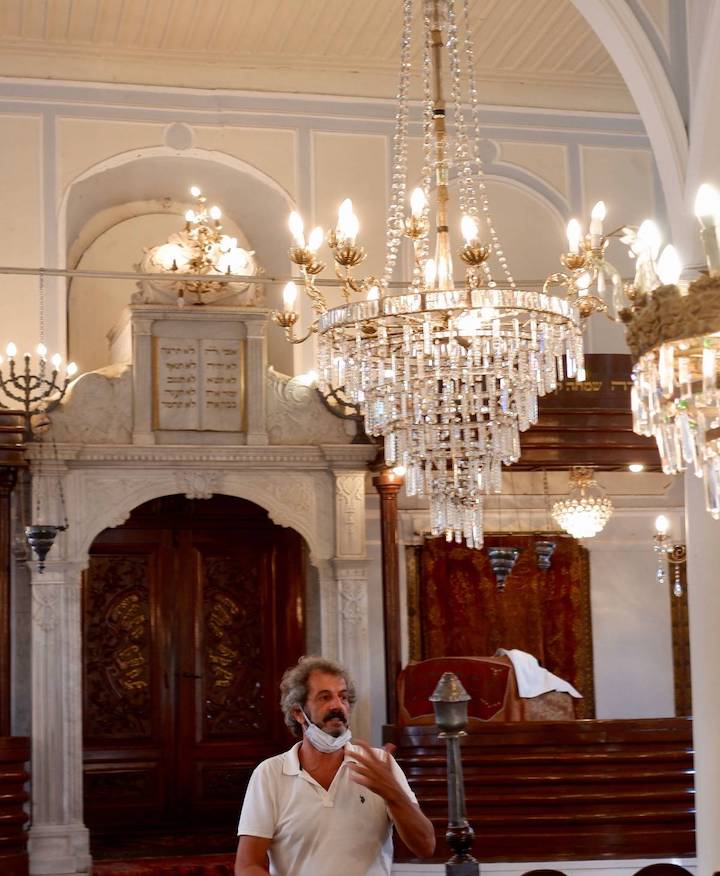
Bencoya in the Signora Geveret Synagogue (Courtesy of author)
Synagogue Street, or Synagogue Market, as Bencoya called it, retains certain traditions dating back to Izmir’s cosmopolitan past. In those days, Jews would go out in their yarmulkes while market sellers would bellow out what goods they were hawking in Ladino, Greek, Armenian, and Turkish. Today only Turkish is heard, and the Jews of Izmir no longer live in Kemeralti but mainly in the nearby district of Alsancak.
Shopkeepers and hoteliers in the area are in favor of its restoration, lamenting the shabby surroundings and the fact that most of the market is pitch black at night, which spooks tourists. “Muslim neighbors feel that something important will happen in the neighborhood. They usually are empathetic to the project,” Bencoya says.
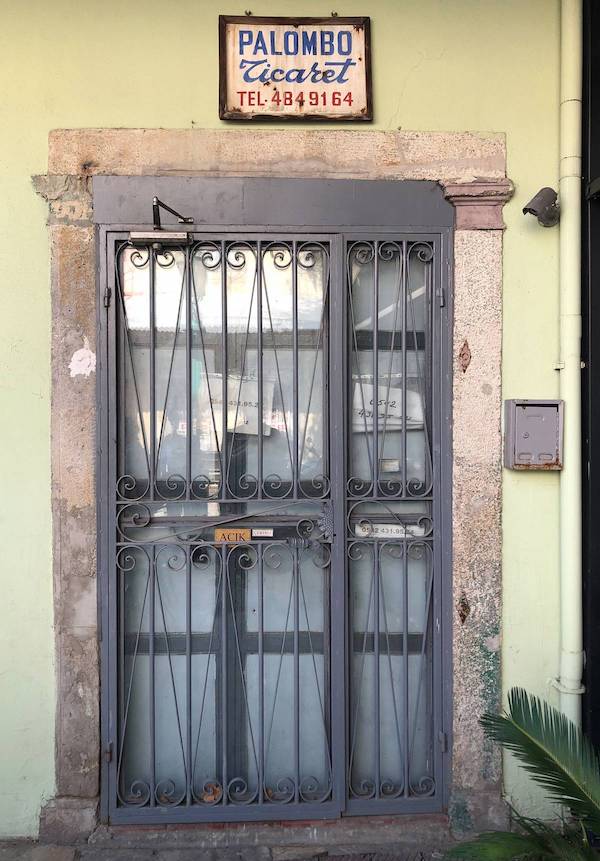
The Palombo caviar shop (Courtesy the author)
Some involved with tourism in the area want to tidy up the street and liberate it from the smelly fish and organ meat vendors, but Bencoya believes it should remain as is. A stone’s throw away is a small shop owned by Rafael Palombo, the city’s last Jewish caviar salesman. It was closed during my visit, but Palombo’s number was written in a note on the window for interested customers. Amid the chaos and overwhelming scents of Synagogue Street, one might spend considerable time there without ever realizing that there are nine synagogues in the immediate area. But there they are, standing as they have for centuries, hidden in plain view.
Related News













